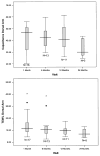A pilot study of emollient therapy for the primary prevention of atopic dermatitis
- PMID: 20692725
- PMCID: PMC3156679
- DOI: 10.1016/j.jaad.2009.11.011
A pilot study of emollient therapy for the primary prevention of atopic dermatitis
Abstract
Background: Prevention strategies in atopic dermatitis (AD) using allergen avoidance have not been consistently effective. New research reveals the importance of the skin barrier in the development of AD and possibly food allergy and asthma. Correcting skin barrier defects from birth may prevent AD onset or moderate disease severity.
Objective: We sought to determine the feasibility of skin barrier protection as a novel AD prevention strategy.
Methods: We enrolled 22 neonates at high risk for developing AD in a feasibility pilot study using emollient therapy from birth.
Results: No intervention-related adverse events occurred in our cohort followed up for a mean time of 547 days. Of the 20 subjects who remained in the study, 3 (15.0%) developed AD, suggesting a protective effect when compared with historical controls. Skin barrier measurements remained within ranges seen in normal-appearing skin.
Limitations: No conclusions regarding efficacy can be made without a control group.
Conclusions: Skin barrier repair from birth represents a novel and feasible approach to AD prevention. Further studies are warranted to determine the efficacy of this approach.
Copyright © 2009 American Academy of Dermatology, Inc. Published by Mosby, Inc. All rights reserved.
Figures
References
-
- Lee J, Seto D, Bielory L. Meta-analysis of clinical trials of probiotics for prevention and treatment of pediatric atopic dermatitis. J Allergy Clin Immunol. 2008 Jan;121(1):116–121. - PubMed
-
- Kopp MV, Hennemuth I, Heinzmann A, Urbanek R. Randomized, double-blind, placebo-controlled trial of probiotics for primary prevention: no clinical effects of Lactobacillus GG supplementation. Pediatrics. 2008 Apr;121(4):e850–856. Epub 2008 Mar 10. - PubMed
-
- Abrahamsson TR, Jakobsson T, Bottcher MF, Fredrikson M, Jenmalm MC, Bjorksten B, Oldaeus G. Probiotics in prevention of IgE-associated eczema: a double-blind, randomized, placebo-controlled trial. J Allergy Clin Immunol. 2007 May;119(5):1174–1180. - PubMed
-
- Taylor AL, Dunstan JA, Prescott SL. Probiotic supplementation for the first 6 months of life fails to reduce the risk of atopic dermatitis and increases the risk of allergen sensitization in high-risk children: a randomized controlled trial. J Allergy Clin Immunol. 2007 Jan;119(1):184–191. - PubMed
Publication types
MeSH terms
Substances
Grants and funding
LinkOut - more resources
Full Text Sources
Other Literature Sources




